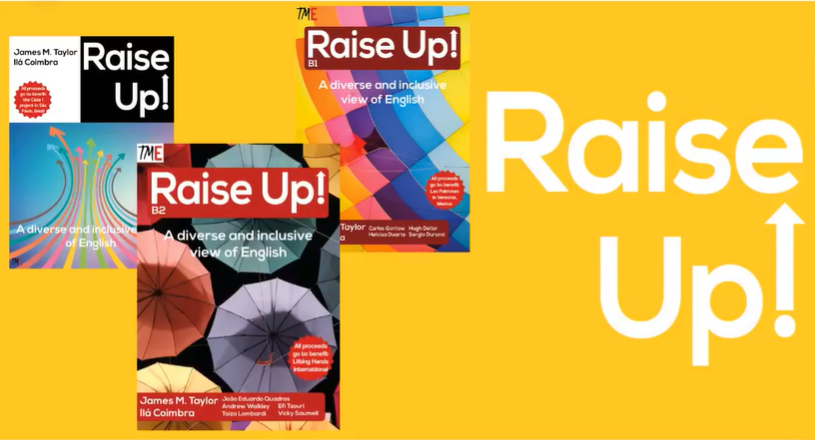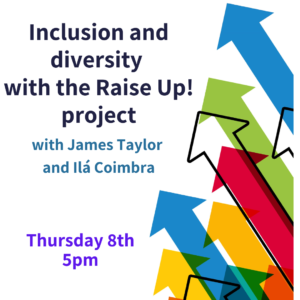As well as showcasing the incredible Raise Up! project, James Taylor and Ilá Coimbra were keen to look at the question of how we can make materials and resources for our lessons more inclusive in the webinar.
What’s the current situation?
White, young, heterosexual, urban, middle-class people are ‘the norm’ in mainstream materials.
From their teaching, training and materials-writing, James and Ilá have gathered a list of groups and identities which are neglected in mainstream ELT materials. This is by no means an exhaustive list – unfortunately it continues to grow rather than getting shorter.
- Women
- Black, Asian and minority ethnic people
- LGBTQIA+
- Disabled people
- The working class
- Indigenous people
- Non-conventional body types
- Non-hegemonic countries and cultures
- Refugees
- People living and working in extreme conditions
- Non-urban environments
- Elderly people
- Aspects of faith
- Neurodiversity
- Immigrants
- Non-conventional families
In some areas there have been improvements: for example there are more women and black people in positions of power now in materials. However, in many other cases, materials provide a stereotypical view of these other groups and identities, if they are even included.
For example, you won’t find families with LGBTQIA+ members represented in materials, whilst disabled people and the elderly are often included but in quite a stereotyped way: the cranky old granny or the cute granny knitting in her rocking chair or the inspirational woman who’s hiking up a mountain in spite of her age – not that there’s necessarily anything wrong with these images, but there’s very little space in materials for elderly people to just live ‘normal’ lives, leading to quite a limited portrayal of the elderly.
Often, when certain groups or identities are included in materials, it’s because they’ve done something incredible…rather than just for ‘being’.
Why is inclusivity and visibility important?
Incorporating these identities which are often under- or misrepresented, has a hugely positive impact in our classrooms:
“You can’t be if you can’t see it.”
Learning a language is a cultural experience so you can come into contact with other worlds and other ways of being, helping them to understand their own place in the world (especially important if they feel they don’t belong when they physically are). Ilá mentioned that a common thing in many trans narratives is the feeling of not belonging and not really knowing who they were until they saw a transgender person – making these identities more visible to them in our materials will help them form their own identity.
Students can be themselves
You create a classroom where learners can be who they really are – something we would all want. For those of us with privilege, we don’t have to hide aspects of ourselves away, but many people do.
Acceptance is motivating
Zoltán Dörnyei one of his key principles of motivation is that you have to feel accepted as you are – if you don’t, it creates a barrier to their learning. Some research suggests that learners grow passive resistance to their learning if they feel their voices aren’t acknowledged. Furthermore, if learners feel they aren’t being represented in the materials, it can make them feel distanced from the language. They need to feel like they belong in the English-speaking world. We are also creating a safe space for all our learners to be who they are in the classroom – this fosters motivation and boosts learning.
Visibility fosters empathy and can help prevent bullying
Deviations from ‘the norm’ is one of the many causes of bullying – when we bring other narratives into the classroom, we can help support learners who might be struggling. Even if your class do fit the ‘norm’, we can introduce our learners to other narratives, helping them to appreciate the differences in the world.
Adapting learning resources
Not all teachers can create new materials for each lesson, but there are ways you can adapted the coursebooks you’re already using.
- Remember your aim is to create an inclusive classroom
The idea is to create a classroom in which each individual feels they belong
- Images and other supplemental materials
You can find alternative images to bring people who are normally not there into the classroom. Take a critical look at any images you choose to include! Ilá shared an image search for gay couples – however, the results were still largely young, white, fit, good-looking…’the norm’.
If different identities are represented in your images, consider how –James shared the image below: the black woman isn’t really a part of the group and she’s staring straight at the camera.

Some photobanks focus on diverse images – James mentioned Unsplash, Nappy, TONL and Black Illustrations and you can find links to others in this blogpost. Remember to use legally-sourced images and to credit images on your materials.
- Discussion questions
These are a great way to change something in the coursebook without creating extra work for yourself! Look at the questions – often used as a lead-in or in follow-up to a receptive skills or language task. It also allows you to ask your learners more critical questions, as coursebook questions can often be fairly superficial. You’re familiar with the context and culture you’re teaching in and also know how far you can take the discussion with your learners.
- Encourage empathy and intercultural understanding, criticism (critical thinking), self-discovery, alternate perspectives and learner-centred learning, not censorship
Asking your learners questions to encourage them to see things from a different perspective builds empathy. Also, by asking your students to think about what isn’t represented in the materials (e.g. during a unit on families, asking, ‘What other types of family can you think of?’), you’re encouraging a learner-centred approach.
When we ask our learners to see things from a different perspective and bring other narratives into the classroom, we’re training our learners to spot injustice, using the language classroom as a tool for social change. Check out Paulo Freire’s Pedagogy of the Oppressed.
If there are materials in a coursebook which you feel aren’t inclusive, rather than ‘censoring’ them, use it as an opportunity to discuss with the learners and think about why they might be inappropriate or too limited.
- Focus on what (or who) is missing, bias and values
Neutral coursebook subjects – shopping, travel, education – these are all laden with values but are often represented in a very superficial way. Although more recent publications are including a more critical approach – e.g. in a unit or shopping, there might be questions about consumerism – we can include more of these questions in our lessons.
John Gray suggests you ask your students:
Why is this topic here?
How is the topic and the subjects being presented?
What other ways of presenting about the topic and subject are there?
- Ask for help
We shouldn’t expect to be able to include everyone in one class, unit, course J
Ilá mentions that one of the biggest challenges for her was knowing how to accurately represent a minority – looking for sources, trying to cover everything that should be included and talking to people.
If you don’t know what terminology to include or if you don’t know how to represent a particular group, ask someone in the know; talk to other teachers who have more experience, look for ready-made resources such as Raise Up!, IDEAL+ or Tyson Seburn’s coursebook sample. It’s important for us as teachers to listen to other narratives as well as we all have unconscious biases.
Another important point is that we’re not including resources inappropriately and exploiting others to include a grammar point:
Be careful not to re-exploit their pain just for the sake of a grammar syllabus. Do not turn the harm, violation and exploitation of enslaved human beings into a convenient tool to introduce the next grammar point. The trauma experienced by victims of human trafficking is not for our pedagogic use. Respect, empathy and justice come first – appropriate lexis, grammar and skills must arise from the theme.
– Judy Boyle
There’s a link to her webinar for the British Council here (thanks to Karen for sharing in the chat). We need to be careful of triggers in the classroom – again, the classroom should be a safe space for students.
James went on to share some examples of inappropriate activities taken from existing materials, such as one which asked learners to discuss whether gay marriage, gay bashing, gay doctors, etc. should be allowed – legitimising the discussion of things which should not be discussed; and another where a friend is asking for advice – however, the depiction of the friend is inappropriate and one of the learners in the lesson may identify with that depiction – how would that make them feel?
Diversity is not likely to happen soon in mainstream publishing, but local publishers and teachers have much more opportunity to bring different topics into the classroom. Also, it would be good for trainers to think about how to raise trainees’ awareness of diversity and inclusion during pre-service training courses so they approach materials with a more critical eye both during the course and when they start working.
Raise Up!
There are currently three books for teens and adults on the market: the first was a multi-level book, written by James and Ilá; next came a B1 book which includes other voices and narratives – half of the book was written by Ilá and the other by guest authors; then they released a B2 book, in which each lesson was written by a different author. This last book includes two audio lessons and also has a powerpoint version available too.
There are also teachers’ notes which are more than just an answer key: they’ve tried to include extra resources and alternate ways of using the material and they’re written for people who might not have experience with the topic, or much experience as a teacher.
There are more books coming this year…
Everyone involved in the project is a volunteer, with all money from the books going to charity:
- Casa 1, a shelter for the LGBTQI+ community in São Paulo
- Las Patronas, a Mexican organization which supports migrants travelling through Mexico to the US border
- Lifting Hands International, a group based in Greece which works with refugees
They also have a blog with articles, lesson plans and interviews for those who are interested in the project. This is particularly useful if you have a materials idea which involves copyrighted material (as this can’t be included in the books).

There is a lack of diversity in ELT materials writers, so James and Ilá are keen to have people get in touch to allow for new voices to get involved. At the same time, it’s important for people with privilege to think about how they can represent people in their materials. They’re looking for editors, illustrators, bloggers…do get in touch if you’re interested!
You can also check out James’ sites: theteacherjames.com and taylormadeenglish.com for lots of lesson plan ideas and resources.

Just came across this site on Twitter which has lots more resources for visuals: https://consciousstyleguide.com/design-images/